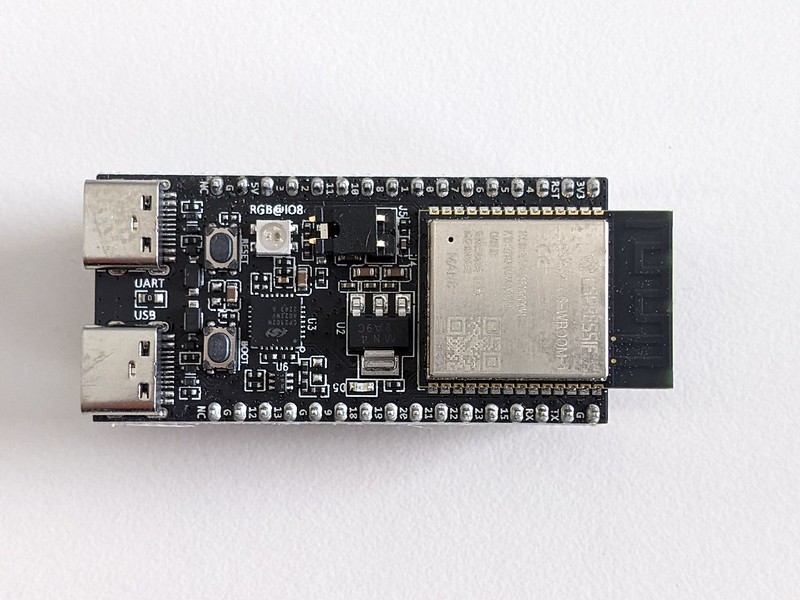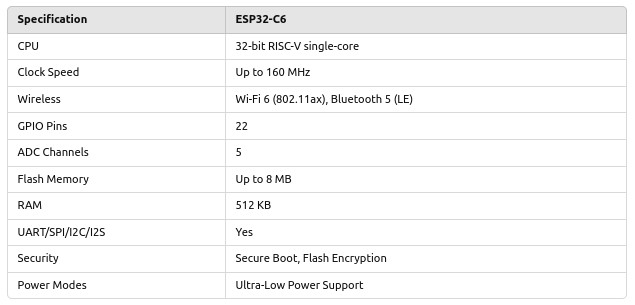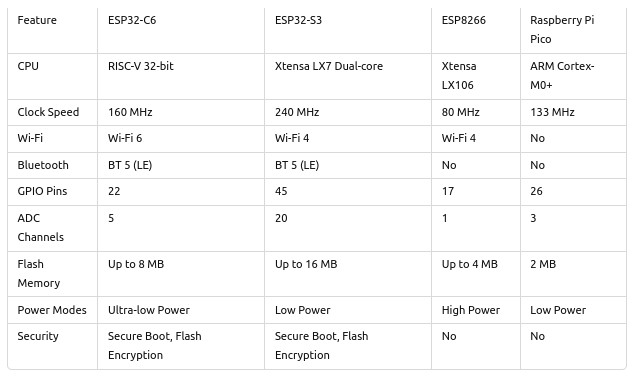ESP32-C6: A Wi-Fi 6 + Bluetooth 5 (LE) SoC
The ESP32-C6 is an advanced system-on-chip (SoC) developed by Espressif, featuring a powerful combination of Wi-Fi 6 (802.11ax) and Bluetooth 5 Low Energy (LE) connectivity. Built on a RISC-V architecture with a 32-bit single-core processor, it operates at up to 160 MHz, ensuring efficient performance for modern IoT applications. With support for OFDMA and MU-MIMO, the ESP32-C6 enhances network efficiency, reducing latency in high-density environments. Its low-power design includes multiple sleep modes, allowing power consumption as low as 0.5 µA in deep sleep, making it ideal for battery-powered devices. Security is reinforced with a hardware cryptographic accelerator, secure boot, and flash encryption. Additionally, it supports up to 32 GPIOs, SPI, I2C, I2S, UART, and ADC interfaces, enabling versatile peripheral integration.

ESP32-C6 Thomas Amberg CC BY-SA 2.0
Key Features of ESP32-C6
The ESP32-C6 is a successor to the widely used ESP32 series, incorporating new wireless standards to meet the growing demands of IoT devices. Below are the primary highlights:
-
Wi-Fi 6 (802.11ax) with improved efficiency and lower power consumption.
-
Bluetooth 5 (LE), allowing longer range and higher data throughput.
-
RISC-V 32-bit processor, optimized for low-power applications.
-
Multiple GPIOs, including ADC, SPI, I2C, UART, and PWM support.
-
Secure Boot & Flash Encryption, ensuring data integrity and security.
-
Low Power Consumption, ideal for battery-operated devices.
-
Enhanced IoT Support, suitable for smart homes, industrial automation, and sensor networks.
Technical specifications
Below is a detailed table outlining the technical specifications of the ESP32-C6:

Comparison with other development boards
How does the ESP32-C6 compare with other popular development boards? The table below highlights key differences.

Applications of ESP32-C6
-
The ESP32-C6 is designed for various IoT applications, including:
-
Smart Home Automation: Controls smart lighting, HVAC systems, and security devices.
-
Industrial IoT: Enhances predictive maintenance, remote monitoring, and smart metering.
-
Wearables & Healthcare: Enables fitness trackers, smartwatches, and medical monitoring devices.
-
Wireless Sensor Networks: Provides reliable data communication in sensor-based applications.
Conclusion
The ESP32-C6 marks a major leap forward in embedded development, integrating Wi-Fi 6 (802.11ax) and Bluetooth 5 Low Energy (LE) with a highly efficient RISC-V architecture. Designed for both consumer and industrial IoT applications, it supports advanced networking features like OFDMA and MU-MIMO, optimizing data transmission in congested environments. With a single-core processor running at up to 160 MHz and ultra-low-power modes consuming as little as 0.5 µA in deep sleep, it strikes an excellent balance between performance and energy efficiency. Enhanced security mechanisms, including secure boot, flash encryption, and a cryptographic accelerator, ensure robust protection against cyber threats. Its rich peripheral support—featuring up to 32 GPIOs, SPI, I2C, I2S, UART, and ADC—makes it highly adaptable for applications ranging from smart home devices to industrial automation. Whether for prototyping, large-scale deployments, or battery-operated projects, the ESP32-C6 provides a flexible and cost-effective solution, rivaling alternatives like the Nordic nRF52840 and the STM32WL series.